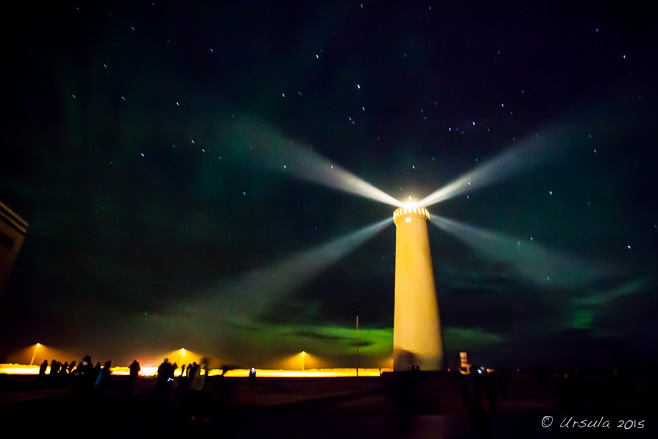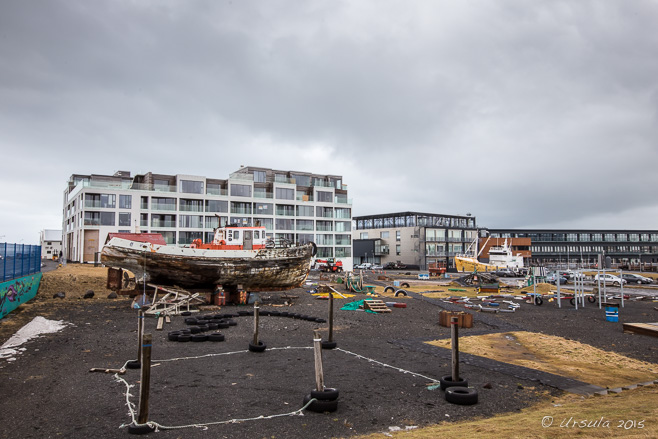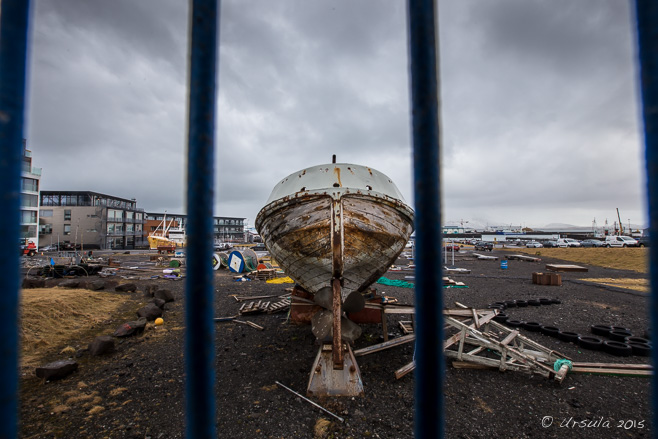
Garðskagi Lighthouse
Garður, a small village on the Reykjanes Peninsula in southwest Iceland, is a popular day-time stop for bird-watchers and picnickers. At night, busloads of tourists arrive from nearby Reykjavík in the hope of seeing the Aurora Borealis.
When travelling in search of natural phenomena, luck is everything.
My husband and I visited Iceland last March for a three-day visit. We were already going to be in England during the northern winter, so when I saw the package “deals” to see the strong>Northern Lights and to go Whale Watching on the North Atlantic, I couldn’t resist.
Of course, whales can be elusive creatures and the Aurora Borealis is not always visible – even in Iceland in winter. Even so, our tickets had to be booked well in advance, and we could only hope for favourable conditions.
As luck would have it, the Northern Lights were the best they had been in years the day before our arrival. The night we were booked to see them, the sky clouded over and it rained, meaning that all tours were cancelled.
On our last day in the country, we crossed our fingers extra-hard for good weather; for while our tour tickets would be honoured for months, our flights were not changeable, and we couldn’t just hang around!
Conditions were far from perfect, but we enjoyed an interesting – if rather long – day anyway. We walked down to Reykjavík Harbour mid-morning so we could see exactly where our whale-watching boat would leave from – and judge how much time we could spend& at the nearby Saga Museum before our sailing.

Boat on the Docks
Old Reykjavík Harbour is an eclectic mix of relatively modern architecture and maritime heritage.

Boat in Drydock
The weathered boats offer up interesting colours and textures.

The Saga Museum
A stunning sculpture of a running horse is installed outside the building on Reykjavík’s Old Harbour that has been the home of the Saga Museum since 2014. We are glad to get inside, out of the rain.

Papar: The First Inhabitants
Iceland’s first residents were papar or “fathers”, believed to be hermit Celtic monks, looking for uninhabited places to contemplate their Christian faith.
The Saga Museum features 17 displays of this type depicting key moments in Icelandic lore and history. The mannequins were very lifelike, and through the displays (some of which are quite gruesome), we learned more about Iceland’s past than we ever thought we’d need to know!

Ingólfur Arnarson and Hallveig Fróðadóttir
The Norse word saga (pl. sögur) means: “what is said, statement” or “story, tale, history”.
The received lore is that Iceland’s first permanent Norse settlers – arriving in 874 – were Ingólfur Arnarson and his wife Hallveig Fróðadóttir. Ingólfur had been forced to leave Norway after reputedly murdering his brother. His step brother, Hjörleifr Hróðmarsson, sailed with them to Iceland – but Hjörleifr was subsequently murdered by his own Irish slaves in retaliation for his mistreatment of them.
The other accepted legend is that when Iceland was first sighted, Ingólfur threw his high-seat pillars (a sign of his being a chieftain) overboard, and decreed that they would all settle wherever the gods chose for the pillars to wash ashore. The wooden pillars, carved with the family name and emblem, and with representations of the gods, were found in the bay which they named Reykjavík.
The stories in the Saga Museum are indeed sögur!

Melkorka Mýrkjartansdóttir and Ólafur Pá
Many of the women in Iceland’s early days were of Celtic origin, captured and enslaved by the Viking men. According to legend, Melkorka Mýrkjartansdóttir, who was later found to be the daughter of an Irish king, was taken into slavery when she was fifteen and purchased by Höskuldur Dala-Kollsson.
Melkorka had a son, Ólafur Pá, of whom Höskuldur was very fond, and who grew up to be a good and generous person.

Úlfljótur and Grímur Geitskór
Around 927 AD, the Icelandic chieftains decided to base their legal system on foreign prototypes. Úlfljótur, a farmer with legal experience, was sent to Norway to study their system of laws, while his foster brother, Grímur Geitskór toured Iceland in search of the most appropriate place for the new parliament. In 930, the Alþingi (Althing), or general assembly, met for the first time in what is now Thingvellir National Park.

Þorbjörg lítilvölva: the Little Prophetess
The ancient Vikings, who believed in the old gods or Æsir, distinguished between völvur, or “seers”, who could predict the future, and witches or sorceresses, who sought to change it. Þorbjörg lítilvölva is described in detail in the Saga of Eric the Red.

Boats on the Docks
After a delicious and uniquely Icelandic lunch at the café at the Saga Museum, we worked our way to the tourist boats…

Whale Watchers
… where the tourists are already in their foul-weather suits.

The Docks
The whale-watching boats leave from the old Reykjavík docks,& …

Reykjavík Harbour
… which have been refurbished for pleasure boats.

North Buoy Marker
Our boat leaves harbour, and heads north …

The Greenland Sea
… into the Greenland Sea.

Northern Fulmar (Fulmarus Glacialis)
In the Greenland Sea, we come across seabirds, …

Watching for Whales
… while the guides keep a lookout for whales. They find some in the distance, and get excited, but – I don’t want to rain on their parade – we get them closer and clearer (and warmer) at home during the annual migrations.

Northern Gannet (Morus Bassanus)
We find more sea birds…

Northern Gannet (Morus Bassanus)
… as they dive in and out of the waters and fly off.

Great Cormorants (Phalacrocorax Carbo)
A ‘gulp’ of cormorants are startled by our approach…

Great Cormorant (Phalacrocorax Carbo)
… and fly off.
We don’t usually eat hot dogs, but we got off the whale-watching boat cold, hungry and a little disappointed at the lack of cetaceans. So, when we came across the little food-stall housing “Bæjarins Beztu Pylsur” (“the best hot dog in town”), which we had heard was “the best hot dog stand in Europe”, we had to join the queue and try one of “Europe’s top 10 local flavours…”
We weren’t disappointed, and the snack fortified us for the long wait until our trip into the night later, in search of the Northern Lights.

Flösin Café and Garðskagi Folk Museum
The night was almost pitch-black as we piled out of our parked busses and, like moths, head towards the only lights.

Garðskagi Folk Museum
The small municipal museum in Garður prides itself on its collection of working Guðni Ingimundarson engines.

Flösin Café Bar
In view of the freezing-cold night air, we were more interested in getting hot drinks at the little bar upstairs…

Looking for the Lights
… before heading outdoors onto the balcony in search of lights. The Aurora Borealis was subtle: most of the time, it could only be seen through the camera lens. It was almost invisible to the naked eye.

Garðskagi Lighthouse
There two lighthouses at Garður; the only one lit against the night sky was the newer, taller (28.6 m) one – built in 1944.

Keflavik International Airport
Morning came only a few hours later, and soon we were back at the airport, watching the sun rise over the terminal. (iPhone)

The Jet Nest
In the cold morning light, we enjoyed another sculpture (see: Reykjavík): this one called The Jet Nest, by Magnús Tómasson. It shows a jet wing breaking out of an egg like a baby bird, and sits on a pile of Icelandic volcanic rock. (iPhone)

“Breeze”
Nína Tryggvadóttir (1913 – 1968) was one of Iceland’s most important abstract expressionist artists. She farewells us with her poetic words at the airport…
“The breeze of your movements still stirs the air though you have gone.”

What a lovely thought – and especially fitting in a country where weather has a personality all its own.
Until next time –
Happy Travels!
Pictures: 19-20March2015
































.png)


Interesting to read your comments about the Aurora Borealis… “was subtle: most of the time, it could only be seen through the camera lens”.
Read an interesting article recently which pointed out that most published aurora images are really misleading due to the greater light sensitivity of modern camera sensors compared to human vision.
Combined with the tendency to over-process images to give a “pleasing” highly colour saturated result, means that people can feel a bit under-whelmed when they see the real thing.
Thanks for sharing another of your adventures with us!
Hi Kevin,
I’m always pleased to have your visits.
The Aurora was, indeed, underwhelming until I noticed the back of someone’s camera, and so started taking and reviewing my own pictures.
In light of your comments, I went back to Lightroom to check if I had added saturation at post-production; I adjusted exposure, contrast, and clarity – but added no more saturation than usual.
Cheers, Ursula